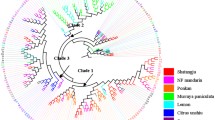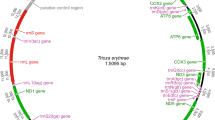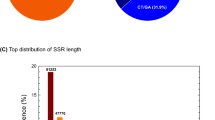Abstract
The Asian citrus psyllid, Diaphorina citri, is a major threat to citrus production worldwide, as it transmits ‘Candidatus Liberibacter asiaticus’, the pathogen associated with the devastating Asian form of huanglongbing. The psyllid has spread widely from its native South Asia during the past 300 years, most recently to Africa. We report the first population genomic analyses of D. citri in Kenya and La Réunion based on next-generation sequencing of their mitochondrial genomes. We analyzed mitochondrial sequences of 264 D. citri individuals to establish genetic relationships among accessions from D. citri populations from Asia, North America and Africa. Haplotype network analysis indicated that the psyllids from Kenya were genetically close to an accession from Cambodia, and distinctly different to those from La Réunion. These findings revealed populations in southern Indochina would be the likely source of the D. citri introduction into East Africa through human-mediated transfer of psyllid-infested plants.

Similar content being viewed by others
Data availability
The sequences generated in this study were deposited in GenBank (Accession number: MW021146–MW021160).
References
Ajene IJ, Khamis F, Ballo S et al (2020a) Detection of Asian citrus psyllid (Hemiptera: Psyllidae) in Ethiopia: a new haplotype and its implication to the proliferation of huanglongbing. J Econ Entomol 113:1640–1647
Ajene IJ, Khamis FM, van Asch B et al (2020bc) Distribution of Candidatus Liberibacter species in Eastern Africa, and the first report of Candidatus Liberibacter asiaticus in Kenya. Sci Rep-UK 10(1):1–10
Ajene IJ, Khamis FM, van Asch B et al (2020c) Microbiome diversity in Diaphorina citri populations from Kenya and Tanzania shows links to China. PLoS ONE 15(6):e0235348.
Arias O, Cordeiro E, Corrêa AS et al (2019) Population genetic structure and demographic history of Spodoptera frugiperda (Lepidoptera: Noctuidae): implications for insect resistance management programs. Pest Manag Sci 75(11):2948–2957
Aubert B (1988) Management of the citrus greening disease in Asian orchards. In: The FAO-UNDP Project Coordinator in Fuzhou (ed) Regional workshop on citrus greening Huanglungbin Disease, Fuzhou, China, 6–12 December, pp 51–52
Aubert B (1990) High density planting (HDP) of Jiaogan mandarine in the lowland area of Shantou (Guangdong China) and implications for greening control. In: Aubert B, Tontyaporn S, Buangsuwon D (eds), Proceedings of the fourth international asia pacific conference on citrus rehabilitation, Chiang Mai, Thailand, 4–10 February 1990. Rome: FAO UNDP, pp 149–157
Aubert B (2008) Huanglongbing (HLB) a graft-transmissible psyllid-borne citrus disease. Diagnosis and strategies for control in Reunion Island. A case study. In: Proceedings of the international research conference on Huanglongbing, December 2008, ed. by Gottwald TR and Graham JH. Plant Management Network, Orlando, FL, USA, pp 23–56. http://www.plantmanagementnetwork.org/proceedings/irchlb/2008/
Aubert B, Bové JM, Etienne J (1980) La lutte contre la maladie du “greening” des agrumes à l’île de la Réunion. Résultats et Perspectives. Fruits 35(10):605–624
Aubert B, Sabine A, Geslin PL et al (1984) Epidemiology of the greening disease in Réunion Island before and after the biological control of the African and Asian citrus psyllas. Proc Int Soc Citricult 1:440–442
Barnes HF (1944) Two new gall midges from Mauritius. Bull Entomol Res 35(3):211–213
Beattie GAC (2020) Management of the Asian Citrus Psyllid in Asia. In: Qureshi JA, Stansly PA (eds) Asian citrus psyllid: biology, ecology and management of the huanglongbing vector. CAB International, Wallingford, pp 179–209
Beattie GAC, Barkley P (2009) Huanglongbing and its vectors. A pest specific contingency plan for the citrus and nursery and garden industries (Version 2), Feb. 2009. Horticulture Australia, Ltd., Sydney, Australia
Beattie GAC, Holford P, Mabberley DJ et al (2008) On the origins of Citrus, Huanglongbing, Diaphorina citri and Trioza erytreae. Proc Int Res Conf 2–5:23–56
Bolger AM, Lohse M, Usadel B (2014) Trimmomatic: a flexible trimmer for Illumina sequence data. Bioinformatics 30(15):2114–2120
Bové JM (2006) Huanglongbing: a destructive, newly-emerging, century-old disease of citrus. J Plant Pathol 88(1):7–37
Bové JM (2014) Huanglongbing or yellow shoot, a disease of Gondwanan origin: Will it destroy citrus worldwide? Phytoparasitica 42(5):579–583
Bové JM, Cassin JP (1968) Problème de l’agrumiculture Réunionnaise. Compt-rendu demission. Doc. IFRA-CIRAD, Paris, p 50
Boykin LM, De Barro P, Hall DG et al (2012) Overview of worldwide diversity of Diaphorina citri Kuwayama mitochondrial cytochrome oxidase I haplotypes: two old world lineages and a new world invasion. Bull Entomol Res 102(5):573–582
Camacho C, Coulouris G, Avagyan V et al (2009) BLAST+: architecture and applications. BMC Bioinform 10:421
Catling HD (1970) Distribution of psyllid vectors of citrus greening disease, with notes on the biology and bionomics of Diaphorina citri. FAO Plant Protect Bull 18(1):8–15
Catling HD (1973) Results of a survey for psyllid vectors of citrus greening disease in Reunion. FAO Plant Protect Bull 21:78–82
Chen QB (1943) A report on a study on yellow shoot of citrus in Chaoshan. New Agric J 3(3–4):142–175 (in Chinese)
Cristescu ME (2015) Genetic reconstructions of invasion history. Mol Ecol 24:2212–2225
de León JH, Sétamou M, Gastaminza GA et al (2011) Two separate introductions of Asian citrus psyllid populations found in the American continents. Ann Entomol Soc Am 104(6):1392–1398
Estoup A, Guillemaud T (2010) Reconstructing routes of invasion using genetic data: Why, how and so what? Mol Ecol 19:4113–4130
French JV, Kahlke CJ, De Graca JV (2001) First record of the Asian citrus psylla, Diaphorina citri Kuwayama (Homoptera: Psyllidae), in Texas. Subtrop Plant Sci 53:14–15
Ghosh A, Jagdale SS, Dietzgen RG et al (2019) Genetics of Thrips palmi (Thysanoptera: Thripidae). J Pest Sci 93(1):1–13
Guidolin AS, Fresia P, Cônsoli FL (2014) The genetic structure of an invasive pest, the Asian citrus psyllid Diaphorina citri (Hemiptera: Liviidae). PLoS ONE 9(12):e115749.
Halbert SE, Manjunath KL, Ramadugu C et al (2010) Trailers transporting oranges to processing plants move Asian citrus psyllids. Fla Entomol 93(1):33–38
Halbert SE, Manjunath KL, Ramadugu C et al (2012) Incidence of huanglongbing-associated ‘Candidatus Liberibacter asiaticus’ in Diaphorina citri (Hemiptera: Psyllidae) collected from plants for sale in Florida. Fla Entomol 95(3):617–624
Hall DG, Richardson ML, Ammar ED et al (2013) Asian citrus psyllid, Diaphorina citri, vector of citrus huanglongbing disease. Entomol Exp Appl 146(2):207–223
Harris KM, Yukawa J (1980) The taxonomic status of the Japanese citrus flower-bud midge, Contarinia okadai (Miyoshi) comb. n., and of the citrus blossom midge, C. citri Barnes. Bull Entomol Res 70(2):277–285
Husain MA, Nath D (1927) The citrus psylla (Diaphorina citri, Kuw.) [Psyllidae: Homoptera]. Memoirs of the Department of Agriculture India. Entomol Ser 10(2):5–27
Katoh K, Rozewicki J, Yamada KD (2019) MAFFT online service: multiple sequence alignment, interactive sequence choice and visualization. Brief Bioinform 20(4):1160–1166
Kobori Y, Nakata T, Ohto Y et al (2011) Dispersal of adult Asian citrus psyllid, Diaphorina citri Kuwayama (Homoptera: Psyllidae), the vector of citrus greening disease, in artificial release experiments. Appl Entomol Zool 46(1):27–30
Lanfear R, Frandsen PB, Wright AM et al (2016) PartitionFinder 2: New methods for selecting partitioned models of evolution for molecular and morphological phylogenetic analyses. Mol Biol Evol 34(3):772–773
Lee JA, Halbert SE, Dawson WO et al (2015) Asymptomatic spread of huanglongbing and implications for disease control. Proc Natl Acad Sci USA 112(24):605–7610
Leigh JW, Bryant D (2015) PopART: Full-feature software for haplotype network construction. Methods Ecol Evol 6(9):1110–1116
Lewis-Rosenblum H, Martini X, Tiwari S et al (2015) Seasonal movement patterns and long-range dispersal of Asian citrus psyllid in Florida citrus. J Econ Entomol 108(1):3–10
Lin KH (1956) Observations on yellow shoot of citrus: aetiological studies of yellow shoot of citrus. Acta Phytopathol Sin 2:1–42
Lin KH, Lin KH (1990) The citrus huang lung bin (greening) disease in China. In: Aubert B, Tontyaporn S, Buangsuwon D (eds), Proceedings of the fourth international asia pacific conference on citrus rehabilitation, Chiang Mai, Thailand, 4–10 February 1990. Rome: FAO UNDP. pp 1–26
Lowe TM, Eddy SR (1997) tRNAscan-SE: a program for improved detection of transfer RNA genes in genomic sequence. Nucleic Acids Res 25(5):955–964
Luis M, Collaza C, Llauger R et al (2009) Occurrence of citrus huanglongbing in Cuba and association of the disease with Candidatus Liberibacter asiaticus. J Plant Pathol 91(3):709–712
Main BJ, Lee Y, Collier TC et al (2015) Complex genome evolution in Anopheles coluzzii associated with increased insecticide usage in Mali. Mol Ecol 24(20):5145–5157
Merilä J, Björklund M, Baker AJ (1996) The successful founder: genetics of introduced Carduelis chloris (greenfinch) populations in New Zealand. Heredity 77(4):410–422
Miller MA, Pfeiffer W, Schwartz T (2010) Creating the CIPRES science gateway for inference of large phylogenetic trees. In: Proceedings of the gateway computing environments workshop (GCE), pp 1–8
Moreria S (1967) Enquête sur les maladies des agrumes, îles Maurice et de la Réunion. Bull Phytosanitaire De La FAO 15:59–60
Nguyen LT, Schmidt HA, von Haeseler A et al (2015) IQ-TREE: a fast and effective stochastic algorithm for estimating maximum-likelihood phylogenies. Mol Biol Evol 32(1):268–274
Novak SJ (2007) The role of evolution in the invasion process. Proc Natl Acad Sci USA 104(10):3671–3672
Oke AO, Oladigbolu AA, Kunta M et al (2020) First report of the occurrence of Asian citrus psyllid Diaphorina citri (Hemiptera: Liviidae), an invasive species in Nigeria. West Africa Sci Rep-UK 10(1):1–8
Om N (2017) The roles of psyllids, host plants and environment in the aetiology of Huanglongbing in Bhutan. Western Sydney University. PhD thesis, pp 1–359
Pieragastini S (2018) State and smuggling in modern China: the case of Guangzhouwan/Zhanjiang, 108–139. Cross-currents: East Asian history and culture review 7(1):118–152
Ramadugu C, Keremane ML, Halbert SE et al (2016) Long term field evaluation reveals HLB resistance in Citrus relatives. Plant Dis 100(9):1868–1869
Rollins LA, Woolnough AP, Fanson BG et al (2016) Selection on mitochondrial variants occurs between and within individuals in an expanding invasion. Mol Biol Evol 33(4):995–1007
Ronquist F, Teslenko M, Van Der Mark P et al (2012) MrBayes 3.2: efficient bayesian phylogenetic inference and model choice across a large model space. Syst Biol 61(3):539–542.
Rozas J, Ferrer-Mata A, Sánchez-DelBarrio JC et al (2017) DnaSP 6: DNA sequence polymorphism analysis of large datasets. Mol Biol Evol 34(12):3299–3302
Rwomushana I, Khamis FM, Grout TG et al (2017) Detection of Diaphorina citri Kuwayama (Hemiptera: Liviidae) in Kenya and potential implication for the spread of huanglongbing disease in East Africa. Biol Invasions 19(10):2777–2787
Saponari M, De Bac G, Breithaupt J et al (2010) First report of ‘Candidatus Liberibacter asiaticus’ associated with huanglongbing in sweet orange in Ethiopia. Plant Dis 94(4):482–482
Schwartz MK, Luikart G, Waples RS (2007) Genetic monitoring as a promising tool for conservation and management. Trends Ecol Evol 22(1):25–33
Sétamou M, Flores D, French JV et al (2008) Dispersion patterns and sampling plans for Diaphorina citri (Hemiptera: Psyllidae) in citrus. J Econ Entomol 101(4):1478–1487
Shimwela MM, Hossein A, Narouei-Khandan HA et al (2016) First occurrence of Diaphorina citri in East Africa, characterization of the Ca. Liberibacter species causing huanglongbing (HLB) in Tanzania, and potential further spread of D. citri and HLB in Africa and Europe. Eur J Plant Patho 146(2):349–368.
Wang YJ, Xu CB, Tian MY et al (2017) Genetic diversity of Diaphorina citri and its endosymbionts across east and south-east Asia. Pest Manag Sci 73(10):2090–2099
Wang YJ, Lu JM, Beattie GAC et al (2018) Phylogeography of Diaphorina citri (Hemiptera: Liviidae) and its primary endosymbiont, ‘Candidatus Carsonella ruddii’: an evolutionary approach to host–endosymbiont interaction. Pest Manag Sci 74(9):2185–2194
Wu FN, Jiang HY, Beattie GAC et al (2018) Population diversity of Diaphorina citri (Hemiptera: Liviidae) in China based on whole mitochondrial genome sequences. Pest Manag Sci 74(11):2569–2577
Acknowledgements
We are greatly thankful to the International Centre of Insect Physiology and Ecology for the sample collection in Kenya. We also appreciate Maéva Vinot and François Hervy for providing the DNA samples from La Réunion through funding by the EU (EFRD, Interreg V) and Région Réunion. We thank the Florida Department of Agriculture and Consumer Services, Division of Plant Industry for support of this work. We are grateful for the financial support provided by Science and Technology Major Project of Guangxi (Gui Ke AA18118046, Zhejiang A&F University impulse project (2019FR029), Science and Technology Project of Guangdong (2020A1414010043) and the National Key Research and Development Program of China (2018YFD0201502).
Author information
Authors and Affiliations
Corresponding author
Ethics declarations
Conflict of interest
The authors declare that they have no conflicts of interest.
Ethical approval
Diaphorina citri is an invasive pest in Kenya and La Réunion, not an endangered species. The individuals from Kenya and La Réunion used in this study were collected from private orchards with the permission of the orchard owners. We did not cause the insects unnecessary trauma (humane treatment).
Additional information
Publisher's Note
Springer Nature remains neutral with regard to jurisdictional claims in published maps and institutional affiliations.
Supplementary Information
Below is the link to the electronic supplementary material.
Rights and permissions
About this article
Cite this article
Wang, Y., Halbert, S., Mohamed, S. et al. Mitochondrial genomes reveal diverse lineages of Diaphorina citri Kuwayama (Hemiptera: Sternorrhyncha: Psyllidae) in Kenya and La Réunion. Biol Invasions 23, 3109–3117 (2021). https://doi.org/10.1007/s10530-021-02560-1
Received:
Accepted:
Published:
Issue Date:
DOI: https://doi.org/10.1007/s10530-021-02560-1




